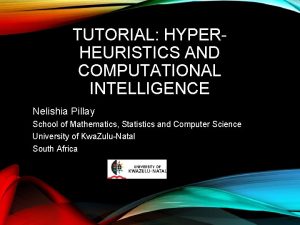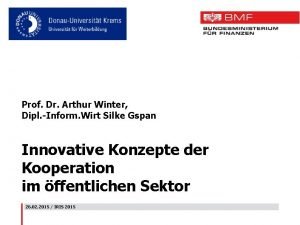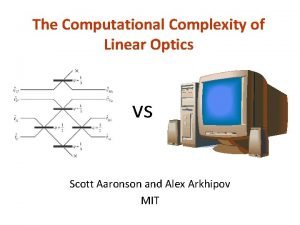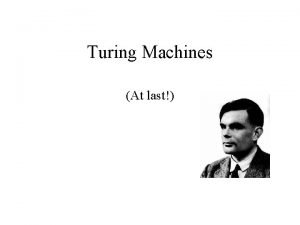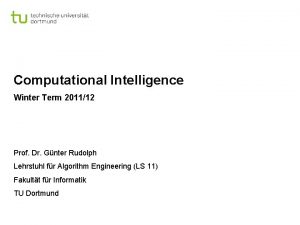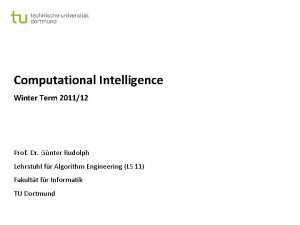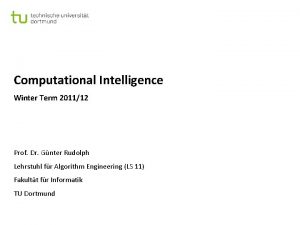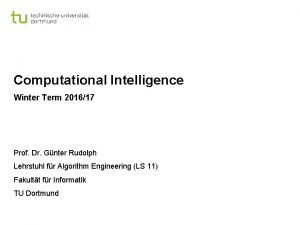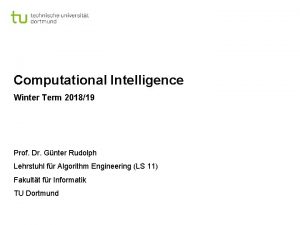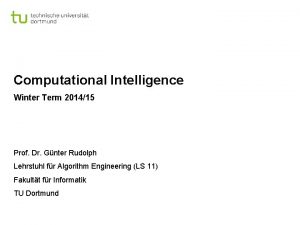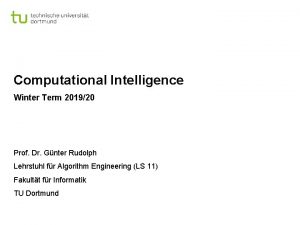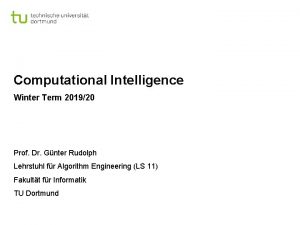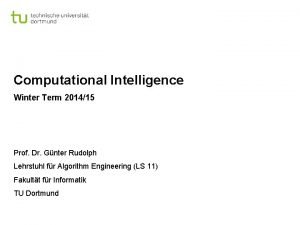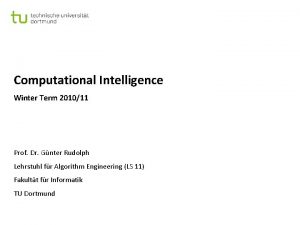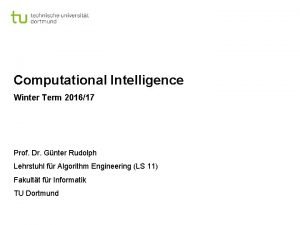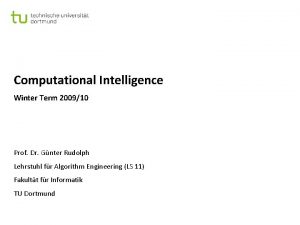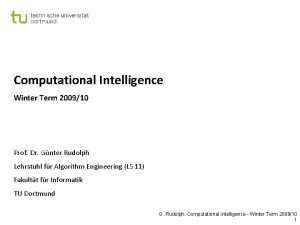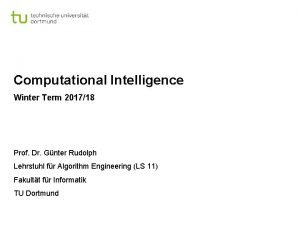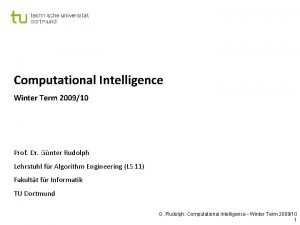Computational Intelligence Winter Term 201112 Prof Dr Gnter























- Slides: 23

Computational Intelligence Winter Term 2011/12 Prof. Dr. Günter Rudolph Lehrstuhl für Algorithm Engineering (LS 11) Fakultät für Informatik TU Dortmund

Plan for Today Lecture 05 ● Fuzzy Sets § Basic Definitions and Results for Standard Operations § Algebraic Difference between Fuzzy and Crisp Sets G. Rudolph: Computational Intelligence ▪ Winter Term 2011/12 2

Lecture 05 Fuzzy Systems: Introduction Observation: Communication between people is not precise but somehow fuzzy and vague. “If the water is too hot then add a little bit of cold water. “ Despite these shortcomings in human language we are able ● to process fuzzy / uncertain information and ● to accomplish complex tasks! Goal: Development of formal framework to process fuzzy statements in computer. G. Rudolph: Computational Intelligence ▪ Winter Term 2011/12 3

Lecture 05 Fuzzy Systems: Introduction Consider the statement: “The water is hot. ” Which temperature defines “hot”? A single temperature T = 100° C? No! Rather, an interval of temperatures: T 2 [ 70, 120 ] ! But who defines the limits of the intervals? Some people regard temperatures > 60° C as hot, others already T > 50° C! Idea: All people might agree that a temperature in the set [70, 120] defines a hot temperature! If T = 65°C not all people regard this as hot. It does not belong to [70, 120]. But it is hot to some degree. Or: T = 65°C belongs to set of hot temperatures to some degree! ) Can be the concept for capturing fuzziness! ) Formalize this concept! G. Rudolph: Computational Intelligence ▪ Winter Term 2011/12 4

Lecture 05 Fuzzy Sets: The Beginning … Definition A map F: X → [0, 1] ½ R that assigns its degree of membership F(x) to each x 2 X is termed a fuzzy set. Remark: A fuzzy set F is actually a map F(x). Shorthand notation is simply F. Same point of view possible for traditional (“crisp”) sets: characteristic / indicator function of (crisp) set A ) membership function interpreted as generalization of characteristic function G. Rudolph: Computational Intelligence ▪ Winter Term 2011/12 5

Fuzzy Sets: Membership Functions triangle function Lecture 05 trapezoidal function G. Rudolph: Computational Intelligence ▪ Winter Term 2011/12 6

Fuzzy Sets: Membership Functions paraboloidal function Lecture 05 gaussoid function G. Rudolph: Computational Intelligence ▪ Winter Term 2011/12 7

Lecture 05 Fuzzy Sets: Basic Definitions Definition A fuzzy set F over the crisp set X is termed a) empty if F(x) = 0 for all x 2 X, b) universal if F(x) = 1 for all x 2 X. Empty fuzzy set is denoted by O. Universal set is denoted by U. ■ Definition Let A and B be fuzzy sets over the crisp set X. a) A and B are termed equal, denoted A = B, if A(x) = B(x) for all x 2 X. b) A is a subset of B, denoted A µ B, if A(x) ≤ B(x) for all x 2 X. c) A is a strict subset of B, denoted A ½ B, if A µ B and 9 x 2 X: A(x) < B(x). ■ Remark: A strict subset is also called a proper subset. G. Rudolph: Computational Intelligence ▪ Winter Term 2011/12 8

Lecture 05 Fuzzy Sets: Basic Relations Theorem Let A, B and C be fuzzy sets over the crisp set X. The following relations are valid: a) reflexivity : A µ A. b) antisymmetry : A µ B and B µ A ) A = B. c) transitivity : A µ B and B µ C ) A µ C. Proof: (via reduction to definitions and exploiting operations on crisp sets) ad a) 8 x 2 X: A(x) ≤ A(x). ad b) 8 x 2 X: A(x) ≤ B(x) and B(x) ≤ A(x) ) A(x) = B(x). ad c) 8 x 2 X: A(x) ≤ B(x) and B(x) ≤ C(x) ) A(x) ≤ C(x). q. e. d. Remark: Same relations valid for crisp sets. No Surprise! Why? G. Rudolph: Computational Intelligence ▪ Winter Term 2011/12 9

Lecture 05 Fuzzy Sets: Standard Operations Definition Let A and B be fuzzy sets over the crisp set X. The set C is the a) union of A and B, denoted C = A [ B, if C(x) = max{ A(x), B(x) } for all x 2 X; b) intersection of A and B, denoted C = A Å B, if C(x) = min{ A(x), B(x) } for all x 2 X; c) complement of A, denoted C = Ac, if C(x) = 1 – A(x) for all x 2 X. ■ A A[B Ac B AÅB Bc G. Rudolph: Computational Intelligence ▪ Winter Term 2011/12 10

Lecture 05 Fuzzy Sets: Standard Operations in 2 D standard fuzzy union A B A[B interpretation: membership = 0 is white, = 1 is black, in between is gray G. Rudolph: Computational Intelligence ▪ Winter Term 2011/12 11

Lecture 05 Fuzzy Sets: Standard Operations in 2 D standard fuzzy intersection A B AÅB interpretation: membership = 0 is white, = 1 is black, in between is gray G. Rudolph: Computational Intelligence ▪ Winter Term 2011/12 12

Lecture 05 Fuzzy Sets: Standard Operations in 2 D standard fuzzy complement A Ac interpretation: membership = 0 is white, = 1 is black, in between is gray G. Rudolph: Computational Intelligence ▪ Winter Term 2011/12 13

Fuzzy Sets: Basic Definitions Lecture 05 Definition The fuzzy set A over the crisp set X has a) height hgt(A) = sup{ A(x) : x 2 X }, b) depth dpth(A) = inf { A(x) : x 2 X }. ■ hgt(A) = 1 hgt(A) = 0. 8 dpth(A) = 0. 2 dpth(A) = 0 G. Rudolph: Computational Intelligence ▪ Winter Term 2011/12 14

Lecture 05 Fuzzy Sets: Basic Definitions Definition The fuzzy set A over the crisp set X is a) normal if hgt(A) = 1 b) strongly normal if 9 x 2 X: A(x) = 1 c) co-normal if dpth(A) = 0 d) strongly co-normal if 9 x 2 X: A(x) = 0 e) subnormal if 0 < A(x) < 1 for all x 2 X. ■ Remark: How to normalize a non-normal fuzzy set A? A is (co-) normal but not strongly (co-) normal G. Rudolph: Computational Intelligence ▪ Winter Term 2011/12 15

Lecture 05 Fuzzy Sets: Basic Definitions Definition The cardinality card(A) of a fuzzy set A over the crisp set X is Rn ■ Examples: a) A(x) = qx with q 2 (0, 1), x 2 N 0 ) card(A) = b) A(x) = 1/x with x 2 N ) card(A) = c) A(x) = exp(-|x|) ) card(A) = G. Rudolph: Computational Intelligence ▪ Winter Term 2011/12 16

Lecture 05 Fuzzy Sets: Basic Results Theorem For fuzzy sets A, B and C over a crisp set X the standard union operation is a) commutative : A[B=B[A b) associative : A [ (B [ C) = (A [ B) [ C c) idempotent : A[A=A d) monotone : A µ B ) (A [ C) µ (B [ C). Proof: (via reduction to definitions) ad a) A [ B = max { A(x), B(x) } = max { B(x), A(x) } = B [ A. ad b) A [ (B [ C) = max { A(x), max{ B(x), C(x) } } = max { A(x), B(x) , C(x) } = max { A(x), B(x) } , C(x) } = (A [ B) [ C. ad c) A [ A = max { A(x), A(x) } = A(x) = A. ad d) A [ C = max { A(x), C(x) } ≤ max { B(x), C(x) } = B [ C since A(x) ≤ B(x). q. e. d. G. Rudolph: Computational Intelligence ▪ Winter Term 2011/12 17

Lecture 05 Fuzzy Sets: Basic Results Theorem For fuzzy sets A, B and C over a crisp set X the standard intersection operation is a) commutative : AÅB=BÅA b) associative : A Å (B Å C) = (A Å B) Å C c) idempotent : AÅA=A d) monotone : A µ B ) (A Å C) µ (B Å C). Proof: (analogous to proof for standard union operation) ■ G. Rudolph: Computational Intelligence ▪ Winter Term 2011/12 18

Lecture 05 Fuzzy Sets: Basic Results Theorem For fuzzy sets A, B and C over a crisp set X there are the distributive laws a) A [ (B Å C) = (A [ B) Å (A [ C) b) A Å (B [ C) = (A Å B) [ (A Å C). Proof: ad a) max { A(x), min { B(x), C(x) } } = max { A(x), B(x) } if B(x) ≤ C(x) max { A(x), C(x) } otherwise If B(x) ≤ C(x) then max { A(x), B(x) } ≤ max { A(x), C(x) }. Otherwise max { A(x), C(x) } ≤ max { A(x), B(x) }. ) result is always the smaller max-expression ) result is min { max { A(x), B(x) }, max { A(x), C(x) } } = (A [ B) Å (A [ C). ad b) analogous. ■ G. Rudolph: Computational Intelligence ▪ Winter Term 2011/12 19

Lecture 05 Fuzzy Sets: Basic Results Theorem Proof: If A is a fuzzy set over a crisp set X then (via reduction to definitions) a) A [ O = A ad a) max { A(x), 0 } = A(x) b) A [ U = U ad b) max { A(x), 1 } = U(x) ´ 1 c) A Å O = O ad c) min { A(x), 0 } = O(x) ´ 0 d) A Å U = A. ad d) min { A(x), 1 } = A(x). ■ Breakpoint: So far we know that fuzzy sets with operations Å and [ are a distributive lattice. If we can show the validity of • (Ac)c = A • A [ Ac = U • A Å Ac = O ) Fuzzy Sets would be Boolean Algebra! Is it true ? G. Rudolph: Computational Intelligence ▪ Winter Term 2011/12 20

Lecture 05 Fuzzy Sets: Basic Results Theorem Remark: If A is a fuzzy set over a crisp set X then Recall the identities a) (Ac)c = A b) ½ ≤ (A [ Ac)(x) < 1 for A(x) 2 (0, 1) c) 0 < (A Å Ac)(x) ≤ ½ for A(x) 2 (0, 1) Proof: ad a) 8 x 2 X: 1 – (1 – A(x)) = A(x). ad b) 8 x 2 X: max { A(x), 1 – A(x) } = ½ + | A(x) – ½ | ½. Value 1 only attainable for A(x) = 0 or A(x) = 1. ad c) 8 x 2 X: min { A(x), 1 – A(x) } = ½ - | A(x) – ½ | ≤ ½. Value 0 only attainable for A(x) = 0 or A(x) = 1. q. e. d. G. Rudolph: Computational Intelligence ▪ Winter Term 2011/12 21

Lecture 05 Fuzzy Sets: Algebraic Structure Conclusion: Fuzzy sets with [ and Å are a distributive lattice. But in general: a) A [ Ac ≠ U b) A Å Ac ≠O ) Fuzzy sets with [ and Å are not a Boolean algebra! Remarks: ad a) The law of excluded middle does not hold! („Everything must either be or not be!“) ad b) The law of noncontradiction does not hold! („Nothing can both be and not be!“) ) Nonvalidity of these laws generate the desired fuzziness! but: Fuzzy sets still endowed with much algebraic structure (distributive lattice)! G. Rudolph: Computational Intelligence ▪ Winter Term 2011/12 22

Lecture 05 Fuzzy Sets: De. Morgan‘s Laws Theorem If A and B are fuzzy sets over a crisp set X with standard union, intersection, and complement operations then De. Morgan‘s laws are valid: a) (A Å B)c = Ac [ Bc b) (A [ B)c = Ac Å Bc Proof: (via reduction to elementary identities) ad a) (A Å B)c(x) = 1 – min { A(x), B(x) } = max { 1 – A(x), 1 – B(x) } = A c(x) [ Bc(x) ad b) (A [ B)c(x) = 1 – max { A(x), B(x) } = min { 1 – A(x), 1 – B(x) } = A c(x) Å Bc(x) q. e. d. Question : Why restricting result above to “standard“ operations? Conjecture : Most likely there also exist “nonstandard” operations! G. Rudolph: Computational Intelligence ▪ Winter Term 2011/12 23
 Aima slides
Aima slides Computational intelligence tutorial
Computational intelligence tutorial Es war eine mutter
Es war eine mutter Winter kommt winter kommt flocken fallen nieder
Winter kommt winter kommt flocken fallen nieder Heute mittwoch guten morgen mittwoch winter
Heute mittwoch guten morgen mittwoch winter Prof. arthur winter
Prof. arthur winter Those winter sundays poetry prof
Those winter sundays poetry prof Minterm and maxterm
Minterm and maxterm Accounting for serial bonds
Accounting for serial bonds Short term planning and long term planning
Short term planning and long term planning Short term finance planning
Short term finance planning Long term hr planning
Long term hr planning Nth term rule
Nth term rule In my understanding
In my understanding Position to term rule worksheet
Position to term rule worksheet Term to term rule
Term to term rule Long term memory vs short term memory
Long term memory vs short term memory Difference between long term and short term liabilities
Difference between long term and short term liabilities Example of long term goals
Example of long term goals Fraction sequence
Fraction sequence Computational diagnostics
Computational diagnostics The computational complexity of linear optics
The computational complexity of linear optics Turing machine 7 tuple
Turing machine 7 tuple Crl radiology
Crl radiology

